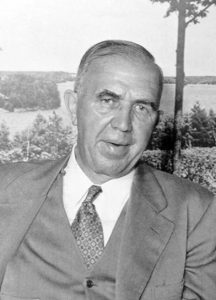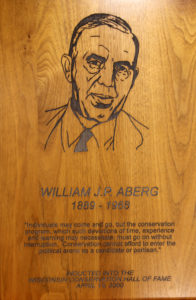1889 – 1968
Inducted 2000
 “Individuals may come and go, but the conservation program, which some deviation of time, experience and learning may necessitate, must go on without interruption. Conservation cannot afford to enter the political arena as a candidate or partisan.” – William J. P. Aberg
“Individuals may come and go, but the conservation program, which some deviation of time, experience and learning may necessitate, must go on without interruption. Conservation cannot afford to enter the political arena as a candidate or partisan.” – William J. P. Aberg
William J. P. Aberg, a native of Sweden and a longtime Madison, WI., resident, is credited with helping to shape two major pieces of legislation affecting Wisconsin’s early conservation efforts. Aberg joined with a group of pioneer conservationists, including Aldo Leopold (WCHF Inductee), to forge the Conservation Act of 1927, which created the Conservation Commission form of resource management.
Aberg also aided in the construction of the state’s forest crop law, which provided an incentive to growers for the perpetual continuation of timber growth and harvesting. Aberg was active in Republican politics, but he remained steadfast in his conviction that politics and conservation didn’t mix.
A front page story in the Wisconsin State Journal of Tuesday, March 19, 1968, announced “Aberg, Conservation Pioneer, Dies.” It credited the native of Sweden with participating in the formulation of two major pieces of legislation affecting Wisconsin’s early conservation efforts.
“Mr. Aberg joined with a group of pioneer conservationists, including the late Aldo Leopold, University of Wisconsin conservation leader, to forge the Conservation Act of 1927, which created the Conservation Commission form of resource management,” the newspaper said. Aberg also aided in the construction of the state’s forest crop law, which provided an incentive to growers for the perpetual continuation of timber growth and harvesting, the newspaper said.
Like several other early conservationists in Wisconsin, Aberg must have performed his conservation duties out of love. He was a successful Madison attorney and active in civic circles, although he was described as a private man. Conservation, though, received a great deal of his attention. Aberg came to the Shell Lake area with his family when he was a child. His origins in Sweden and northern Wisconsin provided the backdrop to a life dominated by love of nature. That would steer him to early involvement with the Izaak Walton League both at the district, state and national level. He was also a founder and member of the National Wildlife Federation.
He worked with Aldo Leopold to refashion the framework of Wisconsin’s conservation system, bringing about major reform that created the citizens’ Wisconsin Conservation Commission. Aberg was a chief architect of the new law, enacted in 1927. Aberg was active in Republican politics, but he remained steadfast in his conviction that politics and conservation didn’t mix. He is also credited with being among a group that fought for restoration of the Horicon Marsh as a wildlife area and the establishment of several national forest areas in the state. Horicon Marsh purchases were accomplished after he became a member of the Conservation Commission.
Resources
Draft letter about reorganization of Wisconsin Conservation Commission by William J P Aberg,
Conservation Reminiscences of William J P Aberg, transcript of audio interview
Haskell Noyes (WCHF Inductee) Marker Dedicated, article by W. E. Scott (WCHF Inductee) for Wisconsin Conservation Bulletin, 1956 (mention nad photo of W. J. P. Aberg)
Photos
These images may be used under the Creative Commons Attribution-NonCommercial-NoDerivatives 4.0 International License.






